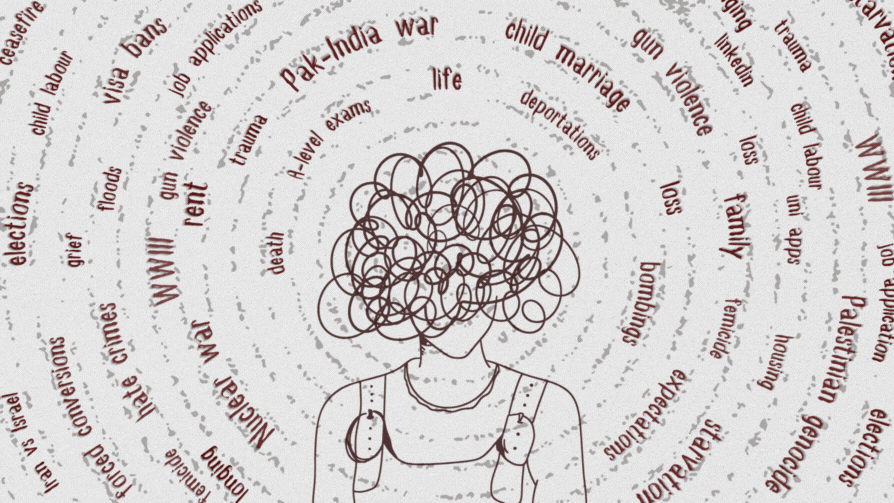How the story of Niazi Qawwals turned from song to struggle
On a cloudy August afternoon, Taj Muhammad, 47, guides me through a narrow, dingy staircase that leads to the first floor of Sharif Manzil.
It is a decrepit building on Moin Niazi Qawwal Street, near the Shoe Market in Karachi’s Saddar Town. This apartment-cum-jam room-cum-office space is not bigger than a small living room. The oil paint on the walls has yellowed. Shapely dust marks on some indicate that a few photo frames have been removed. A cupboard stands shyly in one corner, with musical instruments and an assortment of boxes stacked neatly beside it. A computer desk is the only other form of furniture here.
This is where Taj’s younger brother Faiz Muhammad, 44, and his family live. Almost a year ago, an over-speeding car ran into Faiz’s motorcycle on Sharae Faisal. He was seriously injured. Despite repeated medical treatment, his arms continue to be affected by the accident, making it impossible for him to carry on as a percussionist.
As our conversation proceeds, male members of the household begin to trickle into the room. The talk is primarily about how it has become impossible for the Niazi Qawwal family — after whose father the street they live on is named — to make ends meet. An unpaid electricity bill of 5,607 rupees is offered for viewing in the sunlight seeping through an open balcony door.
Despite running from pillar to post, the Niazis have of late received no financial assistance from the government. Artists with political connections always do. They cannot seem to understand why.
The story of Niazis as qawwals goes back only a few generations. They claim descent from the Atrauli Gharana of music that originates from the eponymous city in present-day India’s Aligarh district. This unexaggerated historical anchorage partially serves the purpose of validation as an authentic qawwal family, as opposed to the many ‘fakes’ around them who trace their ‘fictionalised’ roots to one saint or the other.
The story of Niazi qawwals is also one of survival, underappreciation, deprivation, and a strong sense of entitlement, which to many might seem misplaced. Historically, patronage and art forms have gone hand-in-hand in our part of the world. With time, the former has been slipping away and many are yet to wake up to this reality. Despite running from pillar to post, the Niazis have of late received no financial assistance from the government. Artists with political connections always do. They cannot seem to understand why.

The three sons of Muhammad Ali Munshi — Moin, Haji Ghulam Mohiuddin and Haji Nasir — began showing their predilection for qawwali during their many visits to the shrine of Sufi saint Hazrat Shah Fayyaz in their hometown of Atrauli. Around 1945, the family joined others of their kin in Delhi. Here, they first began frequenting the resting place of 17th century saint Sheikh Kalimullah Jahanabadi and then the 13th century giant of the Chisti order, Nizamuddin Auliya — the patron saint of qawwali. In his mid-teens, Moin formed a party with the help of his brothers and friends and they debuted as a qawwal group. The surname Niazi came from the 18th century saint Shah Niaz, whose order their father had joined years ago.
Following Partition, the Niazis migrated to Pakistan and after a brief stay in Lahore, moved to a house near Karachi’s Ghulam Hussain Qasim Road. It wasn’t until 1981 that they settled in Husain Manzil and Sharif Manzil — two colonial-era dilapidated buildings that sit at the mouth of the present-day Moin Niazi Qawwal Street. In 1993, the Sindh government renamed Meghji Bhagwanji Street after him — his children claim Moin was the first qawwal in history to have received the honour. It does not come as a surprise that the Niazis have grave reservations over the currency of the term Qawwal Gali, even if it is generally used to identify the neighbourhood.
“Just call it Moin Niazi Qawwal Street,” they insist with a sense of pride.

At around 10pm on December 20, 1988, Moin succumbed to brain hemorrhage at Karachi’s Jinnah Hospital. His death also signalled the end of a time when the family seldom worried about finances. Moin’s younger brother Haji Nasir took charge of the deceased’s 11 children and made Moin’s eldest son Ghaus Muhammad, the most famous of second-generation Niazi qawwals, head of the party. Under Haji Nasir’s watchful eye, Ghaus Muhammad excelled as a performer and his four younger brothers — Taj Muhammad, Faiz Muhammad, Shad Muhammad and Ahmed Ali — found their footing.
Nasir’s own progeny, Shaukat Ali, Muhammad Ali and Sultan, also joined their cousins. Not one of them, however, ever attended school. Ghaus Muhammad-Nasir Qawwal Party went on to release 72 albums. Moin had managed only 34, Taj claims. Ghaus Muhammad breathed his last in 2012 and Haji Nasir passed away in 2015.
Faiz Muhammad claims theirs is the only street in the world whose residents have brought home seven government honours — four Pride of Performance awards and three Tamgha-i-Imtiaz
The likes of EMI Pakistan and Shalimar Recording Company used to regularly pay them royalties until the mid-90s when both companies ceased operations. The Niazis are not aware that the former record label EMI Pakistan is back. When approached, EMI Pakistan COO Zeeshan Chaudhry says royalties are still paid regularly, but they are subject to the consumption of the content. A deceased artist’s legal heirs should submit court-issued succession certificates to claim their royalty payments. “Without that, as policy, we will not hand over the royalty to any claimant … even if he/she is a blood relative,” wrote Chaudhry in an email. “The requirement is per the governing laws of Pakistan.”

It is not like the government never recognised the talents of the Niazis.
Following Moin’s death, his wife received a stipend of 750 rupees a month for one-and-a-half years. As the Governor of Sindh in the early ’90s, Fakhruddin G. Ebrahim gave them 20,000 rupees. Moin’s posthumous Pride of Performance award came in 2005, along with a payment of 137,000 rupees. What the Niazis seek, however, is a permanent solution. Maybe rightly so. The last time they played on Radio Pakistan was 20 years ago. PTV allows them a performance in Ramazan every year, against which approximately 4,000 rupees per person is paid. This year that too did not happen because the state television’s budget was not enough. Today, although they play approximately 400 shows a year, the money from those is still not enough to sustain the families of the party’s 12 members as most performances are unpaid, such as at urs celebrations and so on.
There was a time when record labels would pay artists for signing contracts and releasing studio albums. For their 2016 album Kalam-i-Khusro, the Niazis claim they paid record label Heera 85,000 rupees and did not make a penny in return.
“If Atif Aslam also sings Tajdar-i-Haram and Mann Kunto Maula, what is left for us to sing,” asks Shaukat Ali
The Niazis say tradition stops them from experimenting with instruments, newer compositions and innovation of any kind that might help widen their fan base. Shaukat Ali, a father of three daughters, has been leading the party for the last eight to nine years. He is unhappy with popularised versions of age-old qawwalis. “If Atif Aslam also sings Tajdar-i-Haram and Mann Kunto Maula, what is left for us to sing,” he asks. Ahmed Ali rubs his puffy eyes and interrupts, “We play the authentic versions and people ask us ‘What are you playing?’ ”
Despite the odds, they are preparing the next generation to take forward the family trade. Even though Ghaus Muhammad’s boys Zafar and Masood have their own party, the remaining cousins are being trained to take over from Shaukat, Taj Muhammad and Shad Muhammad. All the children go to school, I am told as they fetch instruments to present a specimen of their training. Mann Kunto Maula fills up the room with a warm, lively energy.
Faiz claims theirs is the only street in the world whose residents have brought home seven government honours — four Pride of Performance awards and three Tamgha-i-Imtiaz. Some fans of his father assured him that they have filed an application with The Guinness Book of World Records for this unique feat. The Niazi brothers are hopeful this might fix their broken destiny. They may have a long wait head. Guinness World Records North America Inc. representative Sofia Rocher confirms that the application has yet to be received.
Published in Dawn, ICON, October 1st, 2017










Comments